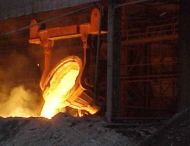المواد الخام البديلة
Alternative raw materials
One way for Lafarge to emit less carbon dioxide (CO2) is to use alternative raw materials to replace limestone in the manufacture of cement. Derived from natural or industrial sources, such alternatives have the same properties as clinker, the main ingredient in conventional cement.
|
Cement manufacturing generates large amounts of CO2 during a physical-chemical process called "decarbonation". In this process, limestone is heated to very high temperatures to produce clinker, which then is ground down to produce cement.
However, the amount of clinker required can be reduced by substituting alternatives called cement admixtures.
Reducing the amount of clinker in cement offers two advantages:
Cement admixtures may be:
Lafarge takes a proactive approach to the use of alternative raw materials, consuming 21 million tons of industrial admixtures each year, with volume growing by 9% annually.
|

Slag in steel plant
Use of alternative materials in the manufacturing process
(P.D.F - 475 حجم الرابط)
ClinkerClinker is the main ingredient in cement. These hardened granules are obtained by firing a mixture of approximately 80% limestone and 20% clay to a high temperature. Cement is obtained by grinding clinker, in some cases supplementing it with additives.
PozzolanPozzolan is named after Pozzouli, a region near Naples, Italy, that is rich in volcanic ash.
Natural pozzolan is a light siliceous mineral produced during basaltic volcanic eruptions. It contains silica, alumina and iron oxide (which gives it a reddish color), as well as lime and magnesium oxide. Pozzolan is used as a cement additive.
Artificial pozzolans with the same properties as natural pozzolans can be created by heating clays, basalts or schists.
Fly ashFly ash is hydrophilic and can be used as a cementitious additive. Typically collected from chimney filters in coal-fired power plants, the ash is composed of vitreous silica, alumina, iron oxide and lime.
Fly ash can be used as a partial substitute for clinker, thus helping to reduce CO2 emissions.
CO2 and cementWhy does manufacturing cement produce CO2?
Cement manufacturing is the source of 5% of global carbon dioxide (CO2) emissions. The cement industry is a natural producer of CO2:
|





